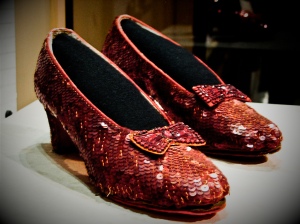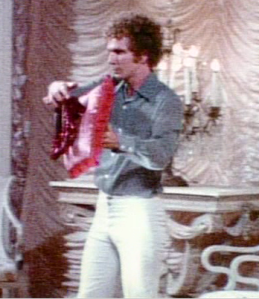
(Image: Source Unknown)
The pair of ruby slippers on perpetual display in the Popular Culture wing of the National Museum of American History at the Smithsonian Institution in Washington, DC, sometimes referred to as ‘The People’s Shoes’, bear a plaque that reads simply:
Sixteen-year-old Judy Garland wore these sequined shoes as Dorothy Gale in the 1939 film classic The Wizard of Oz. In the original book by L. Frank Baum, Dorothy’s magic slippers are silver. For the Technicolor movie, they were changed to ruby red to show up more vividly against the yellow-brick road. One of several pairs used during filming, these size-five shoes have felt soles, suggesting they were used for dance sequences.
However, this omits a great many fascinating details of this particular pair of slippers. These ruby slippers, like the Arabian pair, were found by costumer Kent Warner, who, according to Rhys Thomas, “presented them to the MGM auction officials saying, ‘Look what I found! The ruby slippers!’ Nothing more. He let the auctioneer, and everyone else, assume they were the one, and only pair” (“Treasure”).

As displayed at the MGM auction (Image: Courtesy of Rhys Thomas)
The shoes are in poor condition, relative to other known pairs, clearly, Thomas believes, well worn by Judy Garland during the production (A&E’s “Treasure”). They are widely believed to be the first, and principal, pair worn during the making of the film and, therefore, were in all likelihood, worn more than any other pair known to exist.
These shoes are, according to Thomas, size 5C, and 5BC, and are, therefore, obviously, not a matching set. “On the white kid [leather] lining of the right shoe, the manufacturer’s number has been stamped 5C 15250; on the lining of the left [shoe] the number is 5C 11869 D536” (221). Importantly, according to Thomas, “the numbers in the right shoe of the pair owned by [Michael] Shaw […] [match] the numbers in the left shoe owned by the Smithsonian Institution,” further, “Shaw’s left shoe […] match[es] the Smithsonian’s right shoe” (225). Thomas’s findings, “clearly suggest[…] the shoes themselves were mixed and matched before the sequined overlays were attached” (225).

Kent Warner, holding the ruby slippers, at the MGM auction (Image: Time Warner / Warner Bros.)
This is particularly apparent given the overlays themselves do not match; while “the Smithsonian overlays are rough and worn[,] Shaw’s overlays [were (as of 2005)] in perfect condition” (225). While “the shoes are basically the same size, they are nevertheless subtly different” (225), with the left possessing an overall sleeker appearance, with a slightly higher heel, and longer toe than the right. They are also noticeably sequined differently, with the left shoe sequined very nicely, while the right is more haphazard, with notable gaps in the stitching exposing a great deal of the underlying georgette.
This ultimately means “that Judy Garland wore a wider shoe on her left foot than on her right for [much of] the production of the movie” (225). This also supports the belief “that the basic ruby slipper – the French heeled pump – was purchased in quantity by either Western Costume or MGM, depending on who [one wants to] believe made the shoes” (225) and after dying the white silk shoes red, the overlays were attached without much regard for properly matching the pairs (225). Such disregard, however, seems to support Aljean Harmetz’s claim that the shoes were made by the costumers at MGM.

(Image: The Costumer's Guide to Movie Costumes)
Harmetz wrote simply, in The Making of the Wizard of Oz, “It was in Mrs. Cluette’s Beading Department that Judy Garland’s ruby slippers were made” (239). Marian Parker, who worked in the Wardrobe Department at MGM in 1938, is quoted as telling Harmetz, “The sequins were on a very fine chiffon” [It is, in reality, silk georgette], “and the beaders were working frantically with their little needles pushing those red sequins onto the shoes. They had hoped to get by with just spraying a leather shoe red, but that didn’t work” (239). Vera Mordaunt, who also worked in the Wardrobe Department, told Harmetz, “The first thing, they painted some shoes with a kind of shiny patent-leather paint. They must have tried five or six ways to make the shoes. I think the final shoes were satin. They were definitely some kind of cloth. The chiffon with the sequins was formed in the shape of a shoe and then sew[n] onto the cloth shoe” (qtd in Harmetz, 239)

The Smithsonian Shoes, as worn by Judy Garland (Image: Time Warner / Warner Bros.)
Thomas believes, and photographs support, that the shoes now in the Smithsonian are, the same slippers auctioned by the David Weisz Co, at MGM, on the same soundstage were Judy Garland once began her trip down the yellow-brick road in Munchkinland, on Sunday, May 17, 1970 (221). While “nobody really expected much action from the frumpy pair of sequined shoes” (“Treasure”) they sold for $15,000 (and the bidder was authorized to pay up to $22,000) (Thomas 26; 40). They instantly became the most valuable piece of Hollywood memorabilia in existence (“Treasure”). The anonymous buyer of the slippers is considered by Smithsonian officials “to be the only link between the museum and MGM” (221). The shoes were donated to the Smithsonian in December, 1979, potentially for tax reasons, according to the museum’s technician in charge of the donation, Susan Schreiber (43), and have since been on near-continuous exhibition at the museum.
Physically, undoubtedly following Adrian’s revised designs for the slippers, “the uppers and heels of the Smithsonian pair are covered with red silk faille and overlaid with the hand-sequined georgette. The leather soles are painted red, with orange felt adhered to the front foundation” (Thomas 221). The felt was added “to deaden the noise made during the dance numbers, as MGM’s yellow-brick road was actually made of plywood” (“Treasure”). Further, “[a] black rubber cap, [painted red,] is on the heel of the right shoe, but missing on the left. The bow on the right shoe has 43 rhinestones surrounding bugle beads, and three large red [rectangular] stones in the center; the left bow has 41 rhinestones surrounding the bugle beads and three large stones. Rhinestones are missing on both bows” (Thomas 221).
Concerning the Innes label, it is found “[i]nside the right slipper[, …] embossed […] reading Innes Shoe Co. Los Angeles, Pasadena, Hollywood. The color has been [almost entirely] worn from the label” (221). Despite Schreiber’s assertion that “I am positive there [are] no marks on the shoes. Judy Garland’s name [is] not on them, no numbers, just the manufacturer’s label,” (qtd in Thomas, 43) along the right side of each shoe is, in fact, written JUDY GARLAND in block letters. While the color has greatly worn away, Garland’s name is still present on the shoes.
While the buyer of the ruby slippers at MGM in 1970 and the donor of the slippers to the Smithsonian Institution are unknown, it can be reasonably assumed, according to Thomas, they are one and the same, lending the shoes a, “somewhat clear providence” (222).
October 31, 2010 at 6:59 pm
This was a fascinating read, as was the blog on the Arabian slippers. Thanks!
October 31, 2010 at 7:44 pm
You’re quite welcome Maggie! Much of the information came from the Rhys Thomas book, “The Ruby Slippers of Oz,” along with the A&E special, “Treasure: Search for the Ruby Slippers.” I am happy to hear others are reading, and enjoying, the blog. I thought, while these posts do not directly bear on my own replicating of the shoes, the story of the shoes themselves is extremely interesting, and only adds to the shoes’ allure!
February 13, 2011 at 10:45 am
[…] Following the same method I outlined in the previous post, I have now sequined the heel of both shoes, and I must say they both look markedly authentic, when comparing the design I created with that found in reference images of the Smithsonian shoes. […]